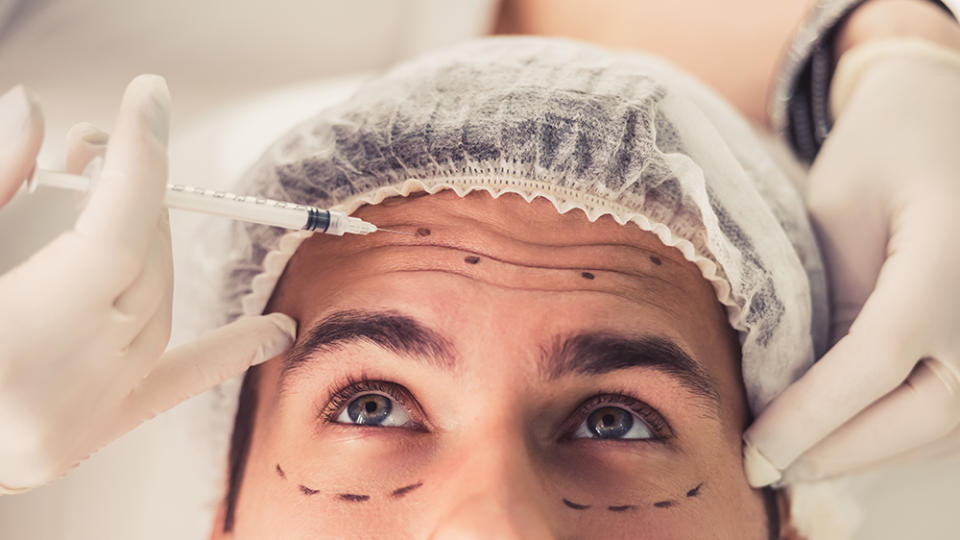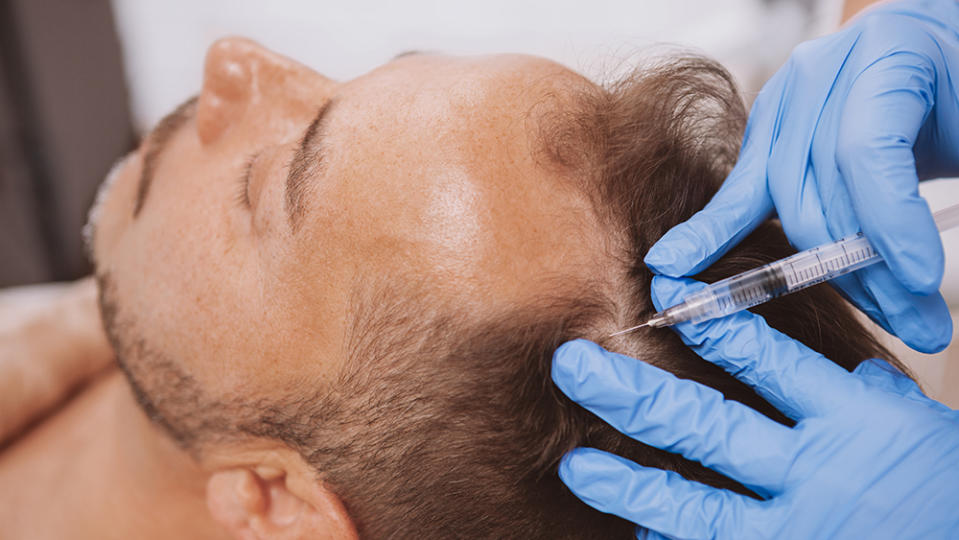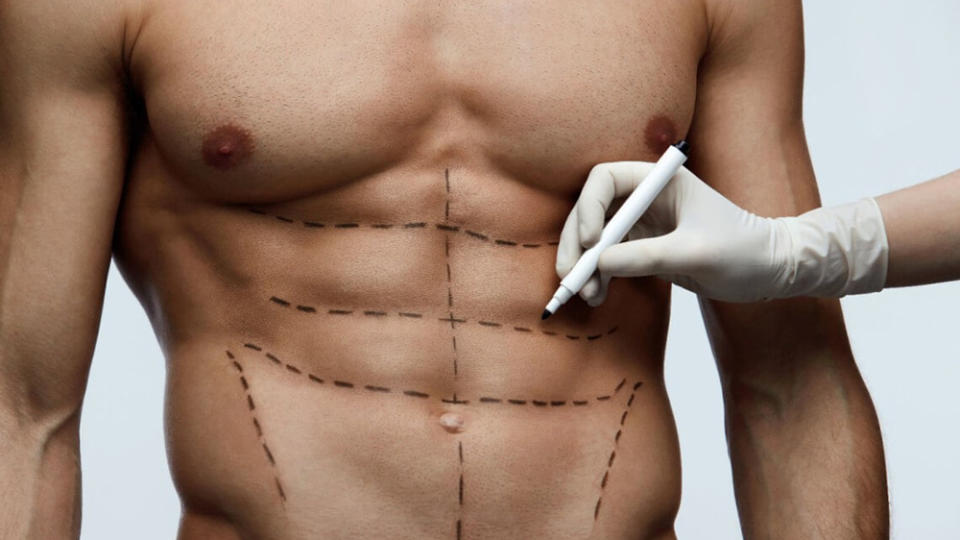Why Men Are Turning to Cosmetic Procedures for a Competitive Edge in the Boardroom

Not long ago, a successful Silicon Valley tech entrepreneur decided to make a risky new investment he’d been toying with for years. “I’d just hit 50 and sold my second company,” he recalls. “I looked at myself and thought, I have another 20 years of work in front of me, so I’m going to go do this now.”
Marc paid $25,000 for a lower face-lift and a nose job. (His name and those of the other patients who spoke to Robb Report have been changed at their request.) “One of the best investments I’ve made,” he says. Unlike other investments in Marc’s career, this one was a closely guarded secret, known only to his doctor, wife, brother—and now you.
More from Robb Report
Nine out of 10 cosmetic procedures in the US are performed on women. Yet to Marc and a growing number of high-flying men, nips, tucks and injections have become stealth weapons to deploy in a Darwinian battle for corporate survival. “I play in the high-tech and start-up world, where older individuals will be passed over,” says Marc, who also got his first Botox shots this year. “The software wars take a lot of energy and commitment. I simply aligned my outer appearance with my inner perspective.”
It’s not just about advantage in a youth-oriented workplace. As gender roles evolve, vanity is losing much of its stigma for men in general. The beauty buffet, once ladies-only, is now open to all, with men increasingly moving from the hors d’oeuvres (grooming, beard cultivation, skin care, dieting and exercising) to the appetizers (cosmetic dentistry, hair replacement, hormone therapy) and on to the entre?es (Botox, fillers, non-invasive fat reduction) before ordering up the pie?ce de re?sistance: plastic surgery. Chanel, Fenty and Tom Ford now also offer a once-unthinkable side dish: makeup for men, leading them into the realm of foundation and eyebrow gel.
Men don’t use the word “beauty,” of course. “Women talk about beauty. Men talk about vitality, virility, competitive edge—that’s a masculine way of describing what is essentially vanity,” says William Liu, professor of psychology at the University of Maryland, who specializes in issues around masculinity. “But what they are really talking about is warding off existential anxiety around death.”
“The idea of stigma has changed,” says Marc. “Women should not always have to look made-up, and men can wear makeup. Those mores are changing. There’s still a little bit of raising an eyebrow right now, but it’s becoming much more acceptable. Some people like to spend money on expensive cars. I like to spend money on myself—I consider my body to be the vehicle I drive in.”
For some, cosmetic procedures fit smoothly into the narrative of personal empowerment and the growing idea that you can create yourself: your gender, your face, your identity. It’s the old American idea of self-improvement, sliced and diced for the 21st century. Behavior that would once have seemed narcissistic has been reframed as an act of self-care. For starters, technology means there’s no longer any need to tolerate physical imperfection. Plus, while millennials are accepting of “quirky” traits and would be loath to admit to holding a single ideal aesthetic, they also consider the very notion of judging other people’s lifestyle choices so old-fashioned that any taboo surrounding cosmetic enhancements seems like a relic from another era. So let’s all get lip fillers.
And they will: Millennials are nearly twice as likely as people over 35 to be considering a cosmetic procedure in the next year, according to a poll last year by RealSelf, a cosmetic-surgery review website. “The trend is toward transparency and removal of stigma for everything to do with self-care and self-love,” says Simon Ourian, M.D., whom Kylie Jenner has credited for
her signature pout with Juve?derm, an investment on which Jenner has since built a nine-figure cosmetics business.
More cosmetic work is done in the United States than in any other country, according to a study by the International Society of Aesthetic Plastic Surgery. In 2018, the last year for which figures are available, the American Society of Plastic Surgeons (ASPS) reports that Americans spent a record $16.5 billion on plastic surgery and its twin progeny, Botox and fillers. Botox and other botulinum-toxin brands accounted for 42 percent of the 17.7 million procedures performed in the US by plastic surgeons that year. The real number of such injections is far higher, because they are also routinely dispensed by dentists, dermatologists, ophthalmologists and even walk-in beauty bars.

More men are being seduced by these speedy pick-me-ups as the barriers to entry, both practical and social, diminish. In the US, male use of fillers and Botox has risen by 101 percent and 381 percent, respectively, since 2000, according to the ASPS, while the number of surgical nose jobs has dropped by 65 percent. Demand for handsome noses has not declined: It’s just that many men now have their noses adjusted with less daunting fillers instead, according to Alan Matarasso, M.D., a plastic surgeon on New York’s Upper East Side.
All the leading cosmetic surgeons and dermatologists interviewed for this article say men account for 20 to 35 percent of their clientele, a proportion that is growing while also broadening in scope. As with most style trends, gay men were the first to catch on. Then came “the metrosexual type that would come in for Botox after their manicure,” as David Mabrie, M.D., a facial plastic surgeon in San Francisco, recounts. Now “it’s more mainstream guys. Guys’ guys.” Men who a few years ago would have considered it a burden to trim a four-inch hair growing out of their ear are now smoothing their fine lines and filling their nasolabial folds.
In New York, the male clientele for Gerald Imber, M.D., has changed from largely those in entertainment to “95 percent CEOs” and similarly accomplished professionals. “These guys spend more on jet fuel coming to New York than they do on me,” he says. Fifteen years ago, says Ourian, his Los Angeles patients were “likely to be in entertainment, but the trend has completely changed and they are now from all walks of life.” He adds that his practice includes “ultra-wealthy businessmen, politicians, heads of state, three kings and five queens.”
Even so, enough residual stigma remains that most men keep their Botox habits secret. And for some, the thrill of a clandestine hobby is part of the appeal. Marc likens it to membership in “an exclusive club.” One of Imber’s patients, a 67-year-old real-estate developer from New Jersey, whom we’ll call Nick, also relishes being a member of “a secret elite club,” in which the members are unknown even to each other. “No one knows about it,” he says. “That’s just my masculine insecurity—it’s a vanity issue. I work a lot with the construction industry, and no one there goes into work and says, ‘I just had a face-lift.’”

Nick felt that his “jowly, hangdog” face didn’t match his gym-honed physique. “I thought, ‘If I cut my head off, I would look a lot younger,’ ” he says with a chuckle. “ ‘But before I do that, I’ll see if Dr. Imber can help.’ ” So three years ago, he took his girlfriend, who’s 20 years his junior, for some couple’s liposuction—“that was the test run”—and followed up with a facelift.
“I checked into the Carlyle, stayed three days, took the wrappings off and went home,” Nick recalls. “When I went out, I ran into people I knew at a restaurant. They asked if I’d been on vacation.” He describes with delight how he was asked for ID at a senior citizens’ lockdown shopping hour at a grocery store in the Hamptons.
Age has become elastic. On the one hand, Nick does not consider himself old at 67, but in youth-obsessed Silicon Valley, 35 is thought over the hill. There, the surgery is starting younger and younger, as tech-industry executives, who are mostly male, strive to appear relevant to their millennial overlords.
Larry Fan, M.D., a San Francisco plastic surgeon, says his clients now describe a work culture where “if they’re over 30 they feel less relevant. Their work involves providing services to younger consumers, and tech luminaries are very young. My patients who are in their 50s say, ‘I’m the old guy in the room, and I don’t want to feel that way.’ Young people have a kind of ‘OK boomer’ mentality.”
Fan says his male patients ask to look like Elon Musk: “He’s aspirational for his work and [looks like he] has had some enhancements done, hair transplants and other things. He looks like a normal person but masculine and chiseled.”
Some of Fan’s patients, whom he describes as “senior tech billionaires with famous names,” regard cosmetic procedures as a form of bio-hacking (see here). “Their mentality is: ‘I want to live forever if I can find a way,’” Fan says. “‘I believe in technology, and part of that is new treatments that help me have fewer wrinkles.’”
Ageism in the tech industry is not confined to Silicon Valley, according to one recruitment executive who worked with software start-ups in New York. “The hiring managers were in their 30s,” he explains. “There are laws against saying you’re looking for someone young, so instead they would say we need a ‘culture fit.’ That was the number-one most important factor. They’re looking for someone to grab a beer with.” The recruiter put it down to “the hubris that comes with gaining a lot of power at an early age. It means that they don’t think they can learn anything from an older person. They feel invincible.”
George, 53, the CEO of a large software company in the Bay Area, agrees that a youthful demeanor is a prerequisite in tech. “Whatever HR says, you do look at pictures when you hire someone, and you look at their digital footprint,” he says. “Are they the right cultural fit? Do they take care of themselves? For better or worse, when you hire someone for a high-stress, high-performance job, part of that is their appearance.”
In 2010, five years after George’s divorce from his first wife, his daughters took charge of his online dating profile. “Being millennials, they said you have to look great online,” he recalls. “I realized that pictures had become very important, not just from a dating perspective but also on LinkedIn. That was a turning point for me.”
He had dabbled in Botox but, with that revelation, became a devotee. “A dermatologist who I played golf with said, ‘If you want to stay looking like that, come in.’ I kept it up until I was 50, then I added fillers once a year, to keep the volume of my face,” George says. Last year, he went to Sachin Parikh, M.D., a Palo Alto surgeon, for a hair transplant. George keeps the procedures private, partly as a career strategy. “I don’t want to talk about it because it’s still perceived as less manly. Also, men don’t like to share tricks that may make them more competitive in the market. I do cryotherapy, I ride the Peloton every day and I’ve had all the genetic testing to see what [conditions] I am predisposed to have, what foods do I process well. I see it all on the same spectrum as bio-hacking.”

The paradox of a man being furtive about a procedure he claims is akin to watching his sugar intake is surprisingly common. “Talking about going to the gym is OK. Talking about getting a haircut is OK,” says Imber. But cosmetic procedures are “something they will do for themselves only, and they do not talk about it.” In a culture of secrecy, it can be hard for surgeons to attract male clients through word of mouth. But once men are through the door, they keep coming back. Parikh describes the typical profile: “The majority have dabbled in teeth whitening and skin care, and they work their way up the ladder from collagen stimulating treatments to fillers and Botox.”
Hair-loss consultations can also be a “gateway drug” to other treatments, says Jessie Cheung, M.D., a Chicago-area dermatologist. “A man will typically come in to talk about losing his hair, and we check for hormone deficiencies,” she says. “If their testosterone is not optimized, I will explain the benefits, and of course they want to perform better. Most clients who come for hormone therapy often get cosmetic treatments, too, and vice versa.”
Other in-demand body treatments for men include CoolSculpting, a form of nonsurgical fat removal using cryotherapy—“wildly popular,” according to Fan, whose clientele for the procedure is 50 percent male—and skin tightening using ultrasound (Ultherapy) or radio frequency (FaceTite). But injectables are the money-spinner: “a 12-year bull run of year-on-year double-digit growth,” says Parikh.

Paul Nassif, M.D., a facial surgeon famous for his TV appearances fixing bad surgery on the E! News show Botched, believes men are becoming more susceptible to the pressures of Instagram perfection. “They are now on the same track as women,” he says. “Eight years ago, men were using Botox for work. Now I would say they are trying to make themselves look better on social media.
With fillers they can look like a filtered photo. We call it selfie dysmorphia.” One of the biggest cosmetic trends of last year was the growth of reversal treatments for faulty fillers and surgical procedures, with liposuction revision up by 183 percent, according to RealSelf.
In New York, Matarasso is expecting a flood of business as soon as lockdown restrictions ease, after months of financiers, lawyers and such inspecting their double chins on Zoom. He believes that the “crazy unemployment rate” will lead to more treatments as job applicants grow desperate to gain an edge over their peers.
As demand for cosmetic enhancement rises, any remaining stigma, even among the middle-aged, seems likely to die away. “When I talk about it with my close friends, I find a lot of them do it, too,” says George, the software CEO. “It’s ‘don’t ask, don’t tell,’ but when you do ask, they do tell.”
Sign up for Robb Report's Newsletter. For the latest news, follow us on Facebook, Twitter, and Instagram.